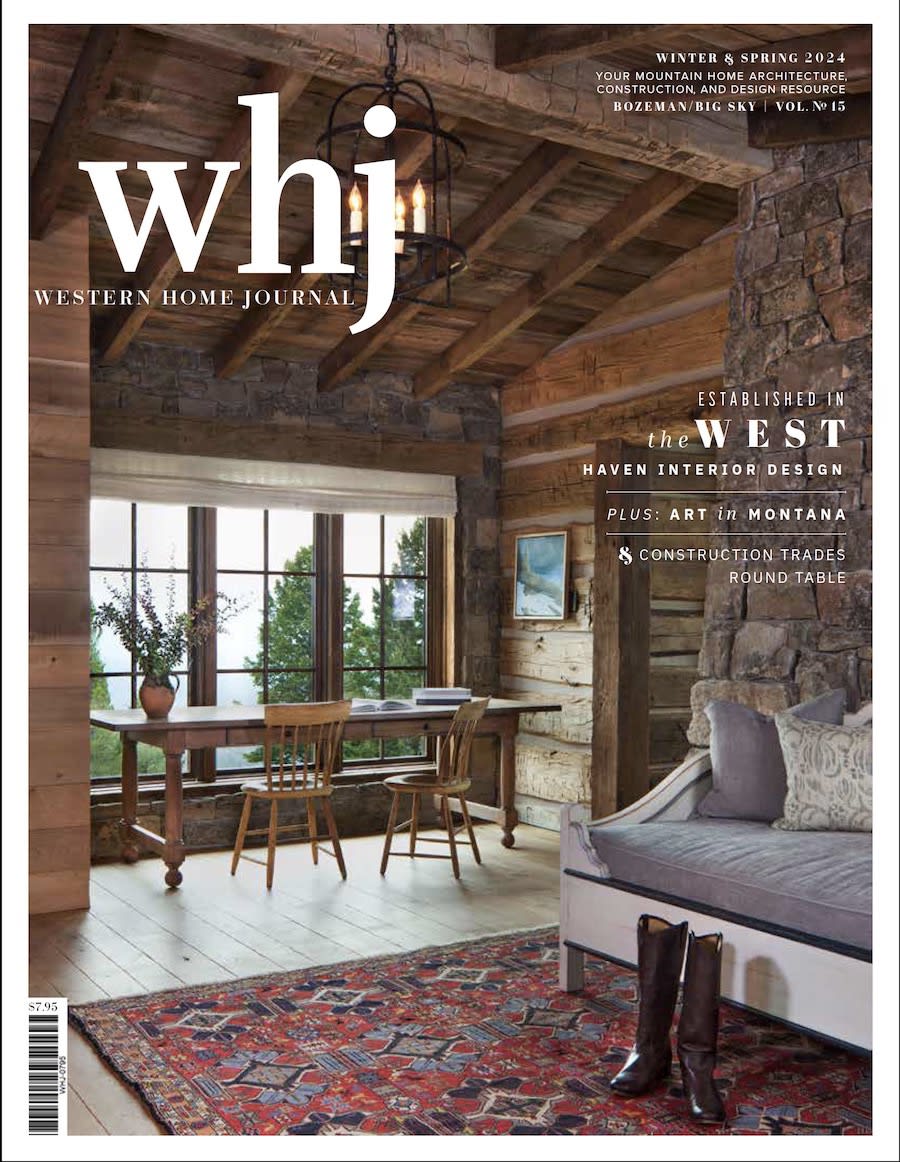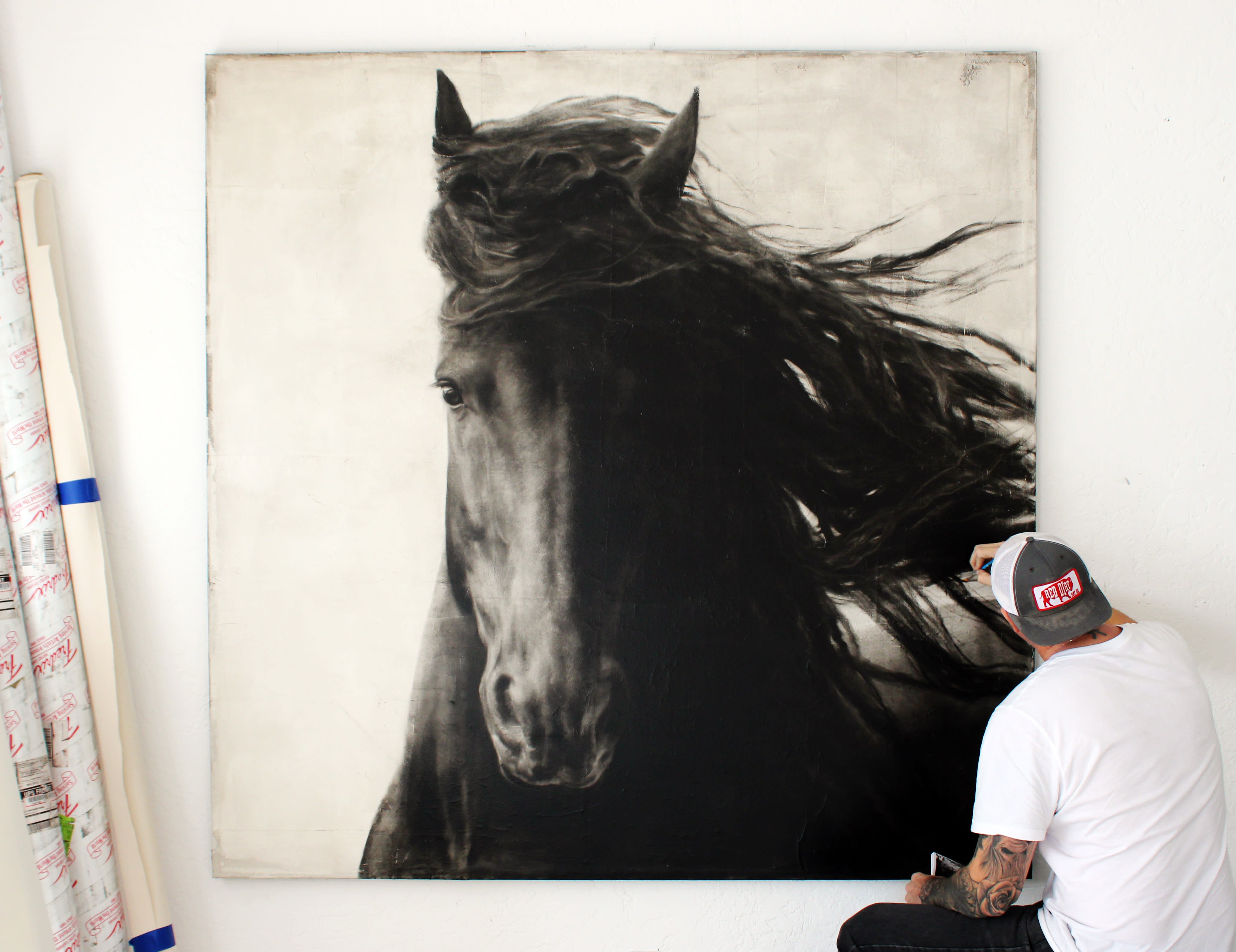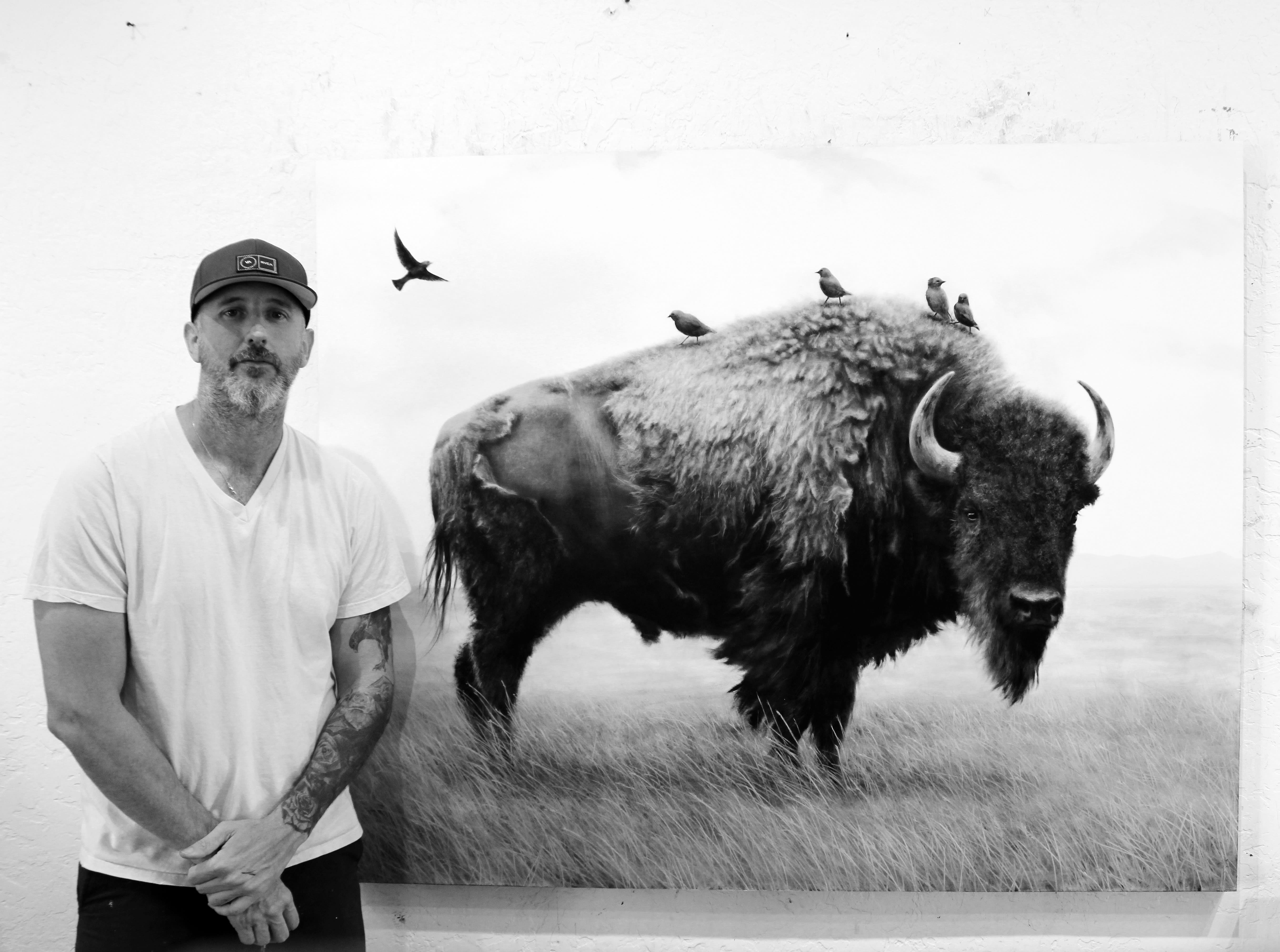

Passage | 72” x 72” | Oil on Panel
The first time Courtney Collins saw Ken Peloke’s large oil paintings she wanted to drop to her knees in admiration.

Free Rein | 48” x 83” | Oil on Panel
“I walked into a gallery in Jackson and saw one of his massive horse paintings,” Collins, owner of Courtney Collins Fine Art, Big Sky, says. “I was so overwhelmed by its intensity, the grace and beauty of the piece; it silenced me with awe. And I thought one day, if I were able to showcase and sell his work, that would be an immense career highlight. Ten years later I’m here and that’s actually what happened.”
Peloke’s large-scale oil paintings command attention. Not because of their size, but because of their presence. Through the textured surface and the distressed treatment of the layers, he creates a kind of wisdom, experiential knowledge that can only be learned by breathing in and out every day.
For Peloke, the first step in creating any painting is the image. “I have to feel the image,” he says. “It’s an emotional experience when I paint.”
Whether it’s the raw edges of nature or the purity of spirit, Peloke completely immerses himself in each painting.
“Lately, I’ve been using photos from a photographer or from someone who has a horse farm because the photograph has so much to do with the finished piece,” he says. Although his paintings may look like photographs at first glance, upon closer observation they reveal a layered surface and a bit of abstract brushstroke and unfinished lines. “Once I have the photo, I change it into black and white. I usually mess with the images and then clean them up before I even start on a painting.”
Using wood panel, or a collaged type of Japanese paper pasted onto the wood panel, Peloke begins with the first of many strata.
“In the beginning I layer,” he says. “Once the layer is where I like it, I’ll start painting, which takes hours of focus.”
The intensity of his focus can be seen in the meticulous renditions of his horses. Rarely is a brushstroke visible, due to a lot of blending. “I try to get it to where it’s photographic from afar,” Peloke says. “I want people to think it’s a photograph at first glance. That’s the feeling I like.”
Once the piece is dry, he goes back in and rubs out half the surface, revealing textures and layers. “I’ll go through and erase quite a bit of work, which brings the aging effect,” he says. “I’ve destroyed pieces doing this. In doing this, there’s this cool thing that comes out. At first, it happened by trial and error.”
The happy accident occurred when Peloke didn’t have much money and didn’t have many canvases or panels, so, if a painting wasn’t right, he would erase it. “It looked like it was burned or maybe printed a long time ago, and I was drawn to that,” he says. “I’ve stuck with that process since I’ve been professionally painting during the last 10 to 12 years.”
The subject of the horse came about due to his wife’s love for them. “My wife is obsessed with horses and had been trying to get a horse of her own ever since I’ve known her,” Peloke says. If he couldn’t give her an actual horse, he thought he’d try to impress her with a painting of a horse. It worked.

Utopia | 48”x 60” | Oil on Panel
While he was painting the horse, the owner of the gallery next to his studio saw the painting. “She asked if I was represented anywhere,” he says. “And I wasn’t. Then she asked, how many pieces do you have? And I answered, I have one.”
She took the horse, and one other painting he was playing around with, to her Sun Valley gallery. A week later, she called Peloke to say she had sold both his pieces. “I told my wife, and it was an amazing thing to experience, so validating to sell my art so quickly, and to have people respond to work,” he says. “There was that connection with the horses.” The Pelokes now have two horses, one for his wife and one for his daughter.
Moving forward, Peloke’s aim is to go with his gut and not worry so much about what people think. He’s taking a month off to recharge, get out of his head, and maybe try some new things. “It took a bit of courage to take the break,” he says. “I’ve had these things in my
head for years but haven’t had the time to get them out.”
It’s also the first year he’s turned down a show. “The last two years have been really busy. I’ve taken a bit of a break; it was much needed,” he shares. “I paint a lot, and I get in my comfort zone and things flow well. But I have to regroup, and recenter.”
He’s been doing some abstract figurative work, just to give his mind some time away from the tight drawings. These pieces are loose, some with only a few wide brushstrokes to hint at the figure of a cowboy.
“It’s a different side of my brain from the focused side,” Peloke says. “There’s an emotional connection with all my pieces; that’s who I am. Especially with animals. I capture a moment with the bison and the horses. With the cowboys it’s a bit more fun. The colors and patterns suggest a vibe that’s coming from the piece – it’s a different thing.”
The abstract paintings feel like a roll of the dice. There are layers and shadow, scraping and adding, that create a depth within the piece. These are condensed biographies, almost x-rays of the figure’s essence. The colors remain black, white, and some browns, but the simplicity of the paintings only adds to the mystique.
“I have no idea where these are going when I start,” he says. “It begins very abstract, then the lines get suggestive. It kind of just happens. It’s another process of layers and scraping, where something beneath is revealed. I love that feeling, that there’s always something deeper than the surface.”
Peloke has been represented by Courtney Collins Fine Art since she opened the gallery, in fact, his work was included in some of the first bodies of work she showed. “I love working with her,” Peloke says. “There are some people you meet when it’s just easy, and things flow. She’s very passionate about her artists. And she takes so much pride in that. That’s important to me. When she speaks to collectors, she represents me like I’m her own.”
Collins recalls her gallery opening with two or three of Peloke’s massive horse pieces and one of his abstract pieces. “That piece was blue like the sea – and the horses around it, and again I had that same feeling of awe to have his work in my gallery,” she recalls. “The surface is just so mesmerizing.”

Breakthrough | 48”x 48” | Oil on Panel
Because Peloke is colorblind, he uses the surface to create color. This beckons to the viewer to ask, “What am I looking at?”
“Through trial and error, he’s made his colorblindness work for him, with layers and media,” Collins explains. “It plays a role in his work. I think it makes him a better artist because he uses that monochromatic palette to tell a story.”
Collins appreciates the depth and scope of Peloke’s work, both the horses and bison compare with the more abstracted figurative paintings. For collectors to have a piece of art on the wall that’s abstract is very different than the intensity of the subjective pieces. Many buy one of each, Collins notes.
“He cares about who represents his work, on a deep level, he cares that the person is passionate about his work,” she says. “I want everybody to fall on their knees when they see his work like I did.”

